Big Bad Wolf
In March 1984, Kings Island announced that The Bat would officially be closed for the entirety of the 1984 summer season while a few modifications were tested on the ride. (That November, they’d conclude that the ride was unfixable, announcing it was closed forever, having unknowingly given its last rides at the end of the 1983 season).
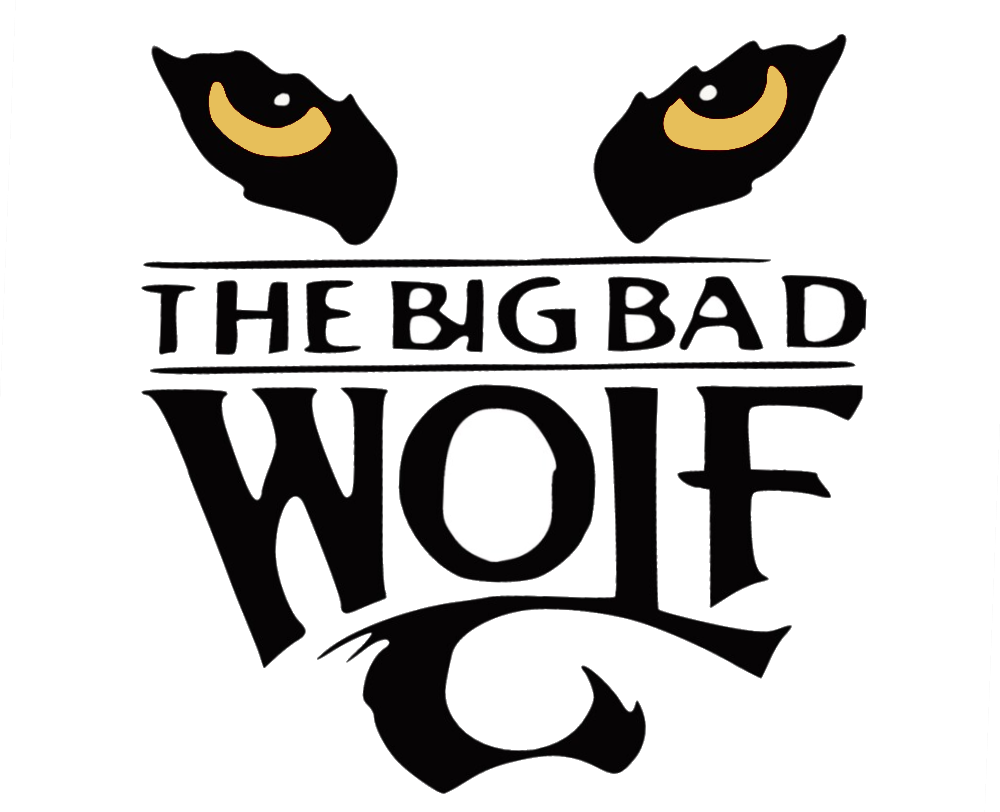
Three months later, on June 15, 1984, at a cost of $6,000,000, a second suspended coaster made its long-awaited debut: Big Bad Wolf.
And like the creature it’s named for, the Big Bad Wolf must’ve felt something like a myth… For one thing, the ride was of a type most guests had never imagined, swinging and swaying beneath the track like no coaster before. But the ride’s most mysterious draw must’ve been just how little guests actually saw of it…
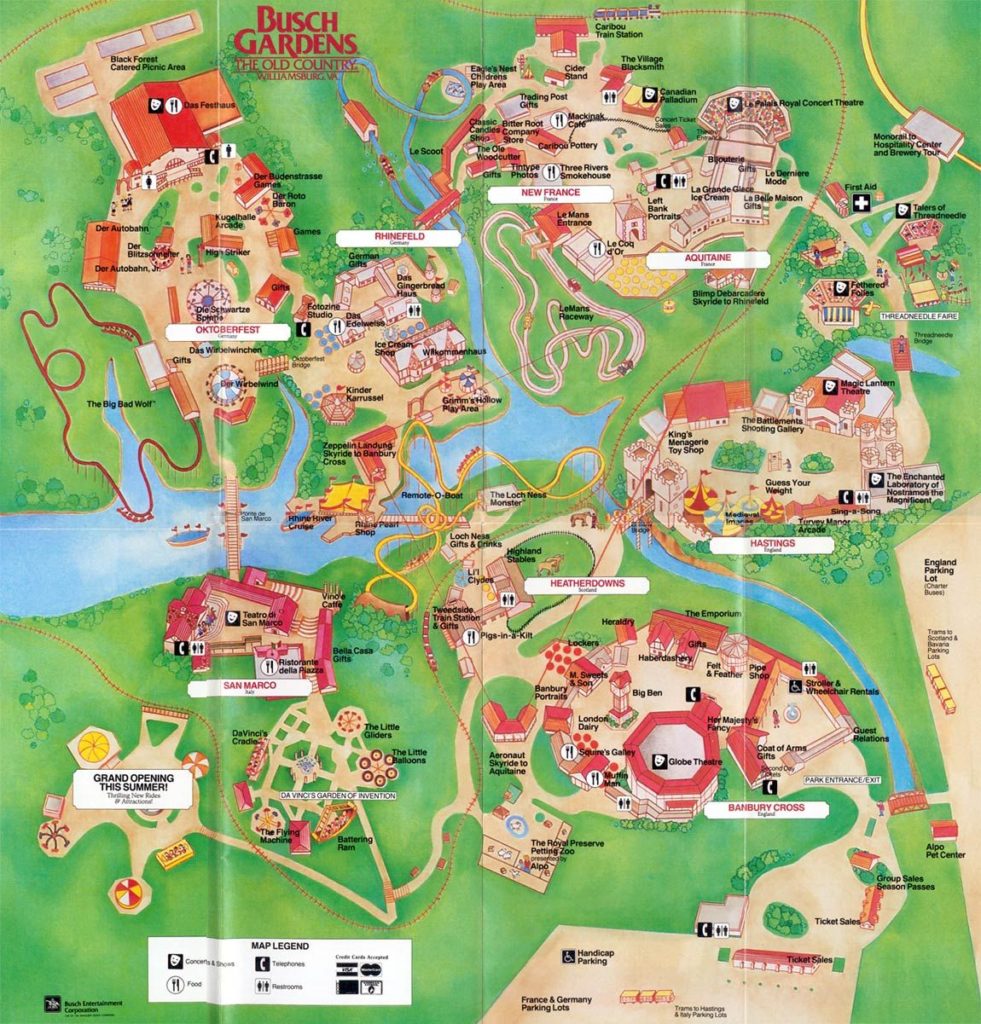
You have to imagine, after all, that nearly the entirety of the Big Bad Wolf’s 2,800 foot course was entirely concealed from guests in the park, hidden from view and set back in the untamed woods just beyond the park’s German-stylized Oktoberfest village. Fitting for the fable it’s based on, the slinking, lurking Big Bad Wolf must be in there somewhere, slaloming between trees, terrorizing towns, and darting through branches… but what, exactly, happened there would be anyone’s guess…
In fact, there’s just one hint as to what the Big Bad Wolf has in store… and it’s a big one. Like no other coaster on Earth, the experience of the Big Bad Wolf begins before you’ve even set foot on the roller coaster itself. After all, your first encounter with it is likely as you approach the park’s Oktoberfest hamlet via el Ponte del San Marco, sixty feet over the Rhine River below… And there, emerging from the unknowable woods at the peak of a steep hill, you see it: crimson red track held aloft by inverted, L-shaped supports…
With a distant roar, a train of suspended, swinging carts emerges from the treeline, rising out of the branches and teetering for a moment atop a hill. Then, the train is released from its chain lift, dipping and bowing out with its hanging cars aligning.
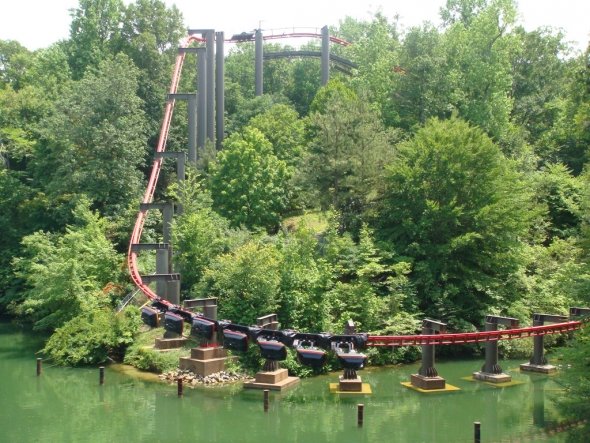
With a breathless moment of peace, the train points down, down, down, barreling along the hillside and racing toward the river below. At the last possible second, the track bows outward, banked parallel to the water’s surface. The train slides along the incline, its swinging arms exaggerating the manuever as riders freely lift up from the force of the turn. With a roar, the sleek, serpentine trains skim across the river’s surface before rushing along the water’s edge and peeling back into the woods.
Frankly, it’s one hell of a tease… and if you want to know what else is hidden in those woods, there’s just one way to find out…
Aboard the beast
Seated aboard the black and yellow trains hanging beneath the striking red coaster track, the Big Bad Wolf begins simply enough: with an recorded spiel inviting you to “enjoy traveling at the speed of fright.”
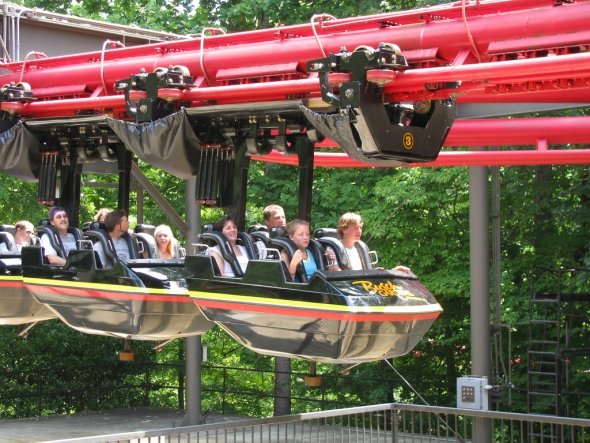
With that, the pneumatic hiss of relaxing brakes allows the train to slowly roll out of the station and down a harmless dip into the ride’s course. But wait… already, you may feel that first innovation of the ride’s – your cart has been released from the under-carriage guide rail that kept it steady for boarding. And even now, the coaster’s growing momentum and the weight of riders reveals that your car is indeed subject to a motion you’ve probably never felt before: with each dip or slight bend in the track – even at this speed – your car compensates by leaning outward, free to sway from supporting arms above.
And that’s not all. Unless you managed to slip away to Ohio’s Kings Island and catch its prototype Bat roller coaster successfully operating, you can’t have experienced anything like what the suspended coaster allows. At once, turning away from the station, you are in the woods. No, really. Look around. Here, hanging from below the track, your car is literally skimming the tops of trees. Even the coaster’s supports become trunks, leaving you floating – yes, floating! – in an endless sprawl of greenery. Yep. You’re lost in the woods…
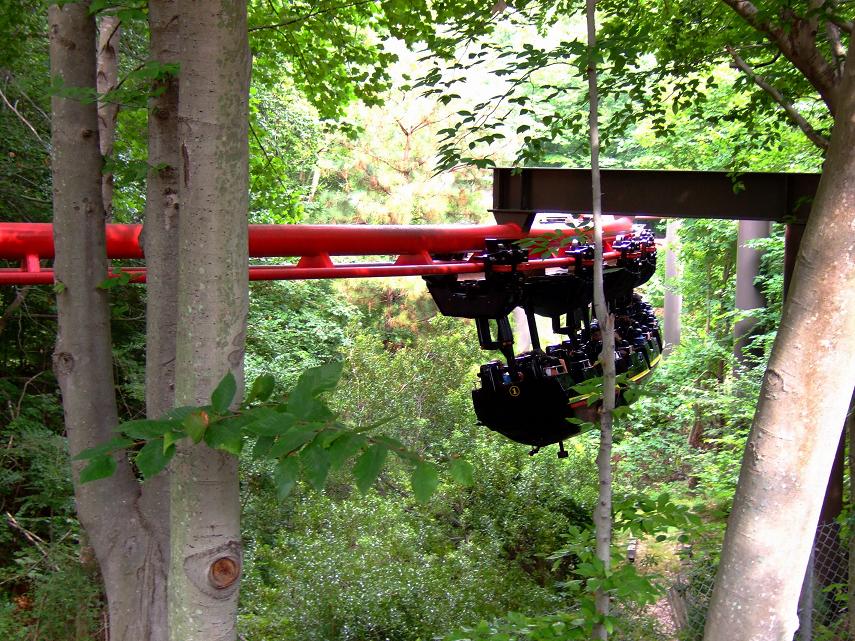
Once sufficiently out of the sight of park guests, the train reaches the ride’s lift hill: 50 feet tall. The click-click-click sound of anti-rollbacks builds anticipation on a ride that, for many, served as their first ever adult roller coaster. The train crests the lift hill and dips down just a bit. Those expecting a white-knuckle thrill and a record-breaking first drop will be surprised. Instead, this dip leads only to a banked turn.
This, though, is where the suspended coaster really gets to show off. As the train swiftly glides through the banked turn, the train swings up to the side in an extreme bank. Just ahead, a wooden building appears. As the train sways wildly, it appears you’re heading right for it! At the last second, you swing away – and right toward a Bavarian stone bridge! Likewise, you narrowly escape.
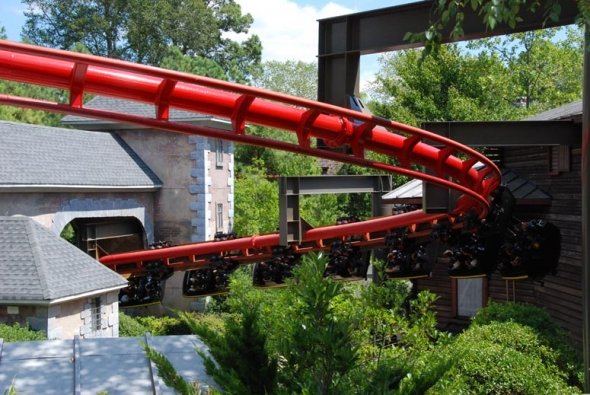
These are Big Bad Wolf’s starring moments: an entire Bavarian village is set among the hilly, forested terrain of the woods. Quaint German shops and Tudor-style homes all covered in crawling vines and flowering ivy. This is when you as the rider begin to realize, you are the antagonist in an age-old fable: you are the Big Bad Wolf, terrorizing this storybook town as you roar along its streets, doors and windows sealed with terrified residents no doubt cowering inside. The fully built village offers one near miss after another as you slalom and swing through the town, narrowly missing trees, fences, doorways, and rooftops.
The village recedes as the coaster gets its first view of an open hillside laced with interlocking roller coaster track – a relentless swaying helix you’re about to race through. Then, the train enters the midcourse brakes and slows for a breath. Don’t get used to it! This is the prelude to one of the most explosive finales on any coaster; a moment that looks much different on-board than it does from the safety of the bridge you stood on a moment ago.
The train crawls up a second lift hill buried among the trees. This one is twice as tall as the first: 100 feet up. At the top, the coaster teases for a moment, slowly circling among the canopies. Then, it turns to reveal the moment you knew was coming: a view out across the endless green of Virginia’s forests… and the Rhine River 100 feet below. It could be that the Big Bad Wolf has saved the best for last.
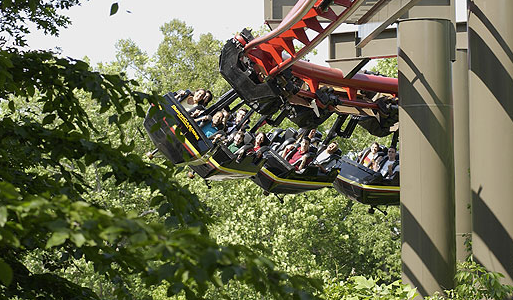
Teetering on the edge for just a moment, the train bends down and races along its biggest drop yet: 80 feet straight down. The train barrels down the drop at 48 miles per hour – its highest speed yet – and races toward the water below. Just before it skims the river, it pulls up and swings wildly out in its most aggressive move yet, absolutely rocketing as it sways up to one side, then the other.
It slaloms back and forth, burning up the tremendous energy of the plunge as it gradually weaves up the hillside and through the forest, darting alongside the bridge and over a gushing waterfall. Somehow, that single dive provided enough momentum to return the Big Bad Wolf back to the top of the hill with the safety of the station just ahead.
As always, we have to include a video that gives you a very real idea of the magnitude and power of Big Bad Wolf. Check it out below:
With its perfect balance of thrills and theming and its equal shares of laughs and screams, Big Bad Wolf was a family coaster few could top. Surprising, powerful, and perfectly sculpted to fit Busch Gardens’ forested terrain, the ride could literally never be duplicated. One-of-a-kind in every way, it was a world class coaster.
But more importantly, it wasn’t just a world class coaster…
Legacy

For generations upon generations of Busch Gardens Williamsburg visitors, the Big Bad Wolf was more than just a ride. This ferocious family coaster twisting through the forests of Oktoberfest is still cited by thousands and thousands of coaster enthusiasts as their first “big” coaster; the ride that cemented a lifelong love of thrills; the adrenaline-pumping experience that changed everything.
Of course, just as many may fondly recall being downright terrified by the ride, swearing off coasters for life… hopefully, to only have their minds changed on a second ride the next summer. But that’s the power of a truly transformative family roller coaster – especially one as brilliantly plotted and spectacularly fun as Big Bad Wolf. It’s more than just a ride – it’s a pivotal moment; a cherished memory; an ice-breaking introduction.
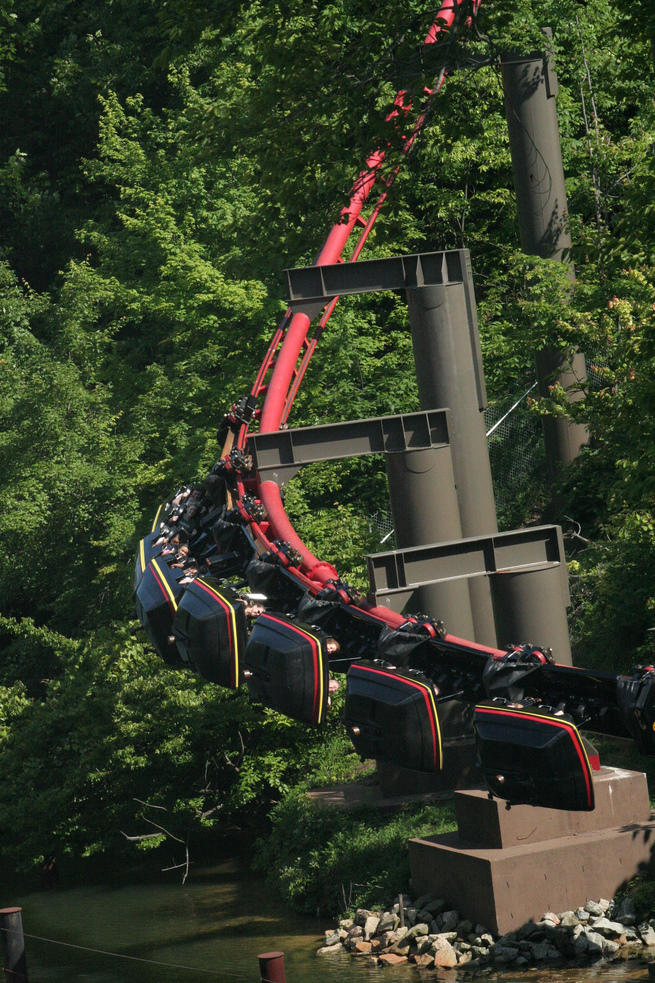
And as one fan’s account of the ride’s final day on fansite BGW Fans proves, it’s more than just people who’re riding on coasters like this one; it’s memories; stories; traditions. So whatever you thought of Big Bad Wolf – and frankly, whether or not you yourself rode it – hopefully you can appreciate the “Big Bad Wolf” equivalent at your local park; your first “big” coaster; a ride rarely spoken of, but widely shared by everyone in your family, school, or state.
In industry terms, Big Bad Wolf wasn’t Arrow’s first suspended coaster, but it was the first to stick around. And though Busch Gardens’ installation arguably remained the most iconic form of the coaster model (in part thanks to its highly customized, terrain-hugging layout and its iconic and unimitable river dive finale), it proved that suspended coasters could bridge a gap in parks’ ride lineups. Just as Arrow’s own “mine train” models had proliferated throughout the ’80s, suspended coasters could be the mid-range rides of the ’90s, perfectly positioned between kiddie coasters and the elaborate thrills not just of Arrow’s nauseating multi-loopers, but of emerging competitors like Vekoma, B&M, and Intamin…
And for a quarter century, Big Bad Wolf did that for Busch Gardens. It was, for residents of Virginia, an icon. A generation of seven year olds who traveled “at the speed of fright” in the ride’s inaugural summer returned with their own seven year old children twenty-five years later, and that in and of itself is a legacy worth remembering. Unfortunately, that generation would be Big Bad Wolf’s last.
The end

Arrow Development may have been the de facto industry leaders of the ’70s and ’80s, but the company endured a number of takeovers, changing-of-hands, and engineering issues throughout the ’90s.
Perhaps most simply, tastes changed. By the 1990s, new coaster manufacturers like Bolliger & Mabillard and Intamin were innovating with new, computer-plotted, and effortlessly smooth steel coasters. Arrow’s doomed attempts to keep up with ’90s newcomers is perfectly exemplfied by a ride built just feet away from the Big Bad Wolf: 1992’s Declassified Disaster: Drachen Fire. An industry embarassment, the ride really was Arrow’s best impersonation of a modern, smooth, stylish coaster. While Drachen Fire looked like a B&M, it didn’t feel like it.
Arrow played a decade’s worth of catch-up risking it all with Six Flags Magic Mountain’s 2001 “4th Dimension” coaster, X, whose development ultimately bankrupted the company. Arrow coaster today are serviced by S&S Sansei, in whom Arrow’s assets continue.
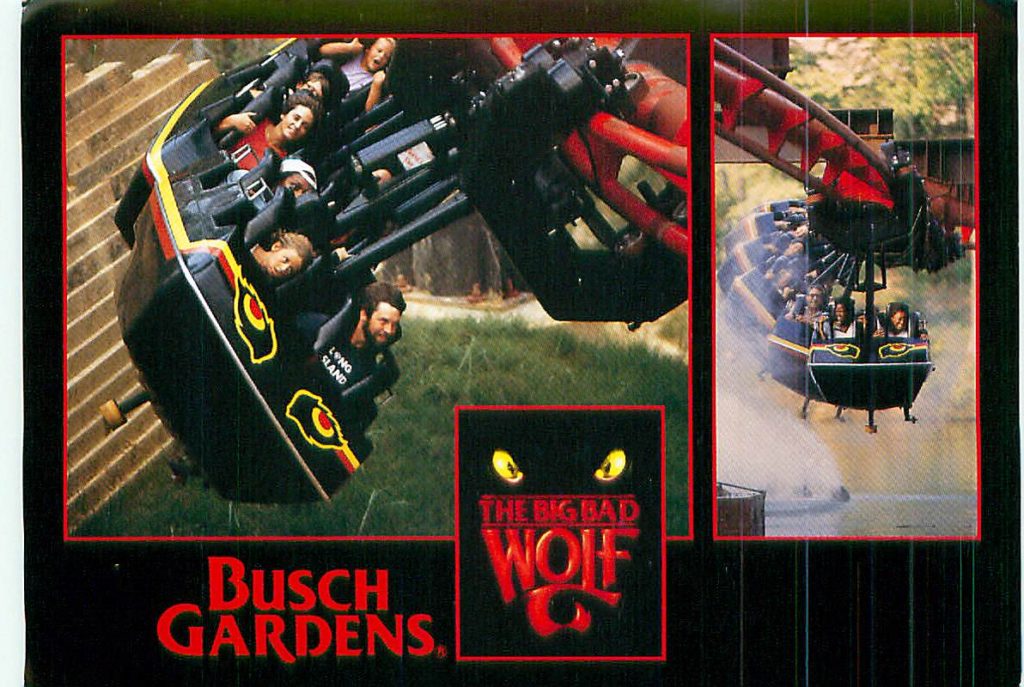
On July 24, 2009 – eight years after Arrow’s bankruptcy – Busch Gardens announced that that summer would be Big Bad Wolf’s last. They cited a 25-year shelf-life recommendation from the manufacturer. In some regards, it makes sense. Replacement parts are (and will continually be) increasingly difficult to attain for older coaster models. And as Arrow itself discovered, sometimes tastes simply change. Rides built with today’s technologies can make coasters from the ’70s and ’80s feel downright discombobulating.
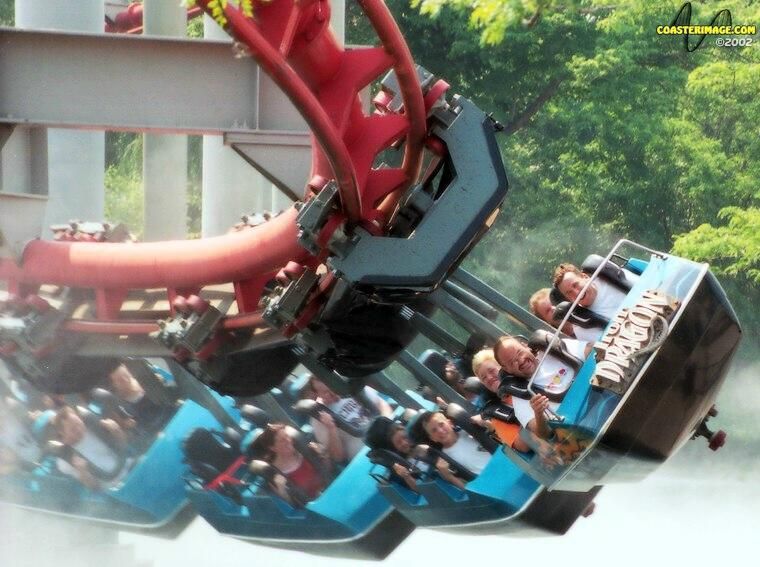
Of course, that’s not to say suspended coasters are extinct or even outdated. Big Bad Wolf was one of very few suspended coasters left in the world – and by far the oldest – but it’s survived by five other installations. The eldest four are Iron Dragon at Cedar Point (1987), Ninja at Six Flags Magic Mountain (1988), Vampire at Chessington World of Adventures (albeit, with modified trains) (1990), and Vortex at Canada’s Wonderland (1991).
The fifth might surprise you: taking everything they’d learned since the failure of The Bat at Kings Island, Arrow returned to the site of their first and failed suspended coaster and constructed Top Gun: The Jet Coaster in 1993. Yep, the same park that had prototyped the first suspended coaster became home to the last. Top Gun was unfortunately renamed the more generic Flight Deck when Kings Island passed from Paramount’s ownership to Cedar Fair’s in 2007, but the poetic nature of the ride wasn’t lost for long…
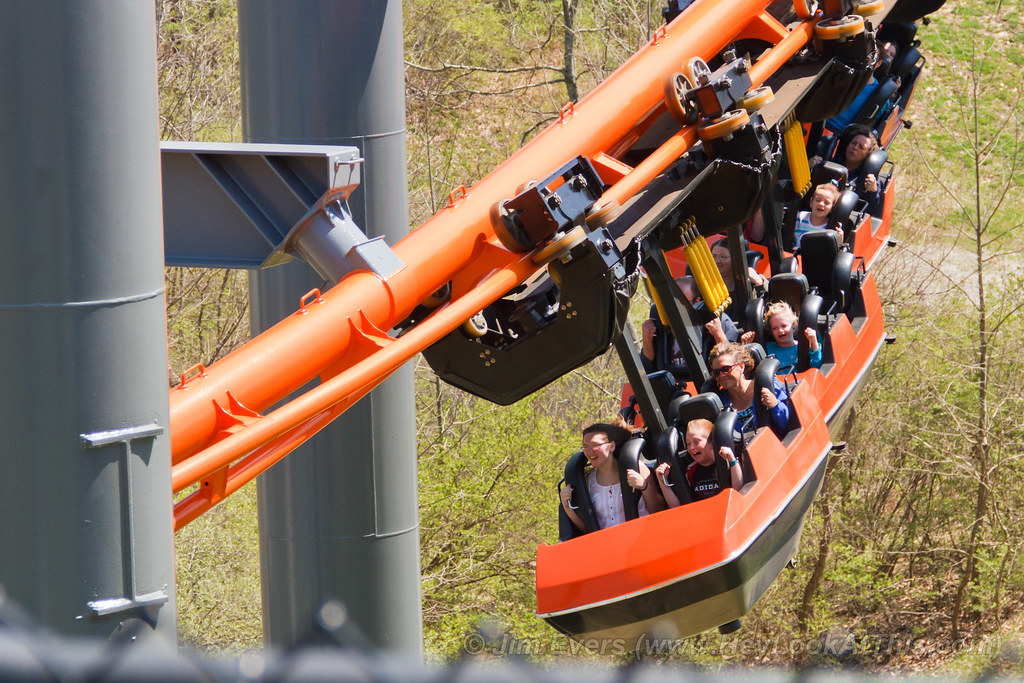
In 2014, in a clever nod to nostalgia, Kings Island’s ride gained a striking new orange and gray color scheme and a surprising new name: The Bat (1993). Yep, just steps away from where the short-lived prototype once flew, its namesake lives on, still fluttering through the forested hillsides of Ohio.
Big Bad Wolf was demolished, leaving only its concrete footers visible along what had been the iconic river dive finale. The vacant station and now-empty woods were a visible and unfortunate reminder of what had been, and families no doubt lamented the loss of such a wonderful introductory roller coaster. But such prime real estate wouldn’t stay vacant for long. Some park fans imagined that the massive plot of land Big Bad Wolf had occupied might be reborn as a brand new themed hamlet for the park – perhaps Russia or Spain might finally join the park’s Italy, France, Canada, Ireland, Scotland, and England.
But the park had other plans. For one, the concrete footers left along the river remained intentionally. They would be used again… Read on…


